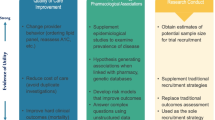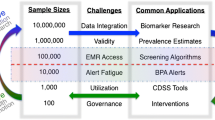Abstract
With growing adoption and use, the electronic health record (EHR) represents a rich source of clinical data that also offers many benefits for secondary use in biomedical research. Such benefits include access to a more comprehensive medical history, cost reductions, and increased efficiency in conducting research, as well as opportunities to evaluate new and expanded populations for sufficient statistical power. Existing work utilizing EHR data has uncovered some complexities and considerations for their use but, more importantly, has also generated practical lessons and solutions. Given an understanding of EHR data use in cardiovascular research, expanded adoption of this data source offers great potential to further transform the research landscape.
Similar content being viewed by others
Abbreviations
- CPT:
-
Current procedural terminology
- EHR:
-
Electronic health record
- eMERGE:
-
Electronic Medical Records and Genomics
- GWAS:
-
Genome-wide association study
- ICD:
-
International Classification of Diseases
- NLP:
-
Natural language processing
- QDM:
-
Quality Data Model
- SHARP:
-
Strategic Health IT Research Program
- SVM:
-
Support vector machine
References
Hsiao, C.-J., & Hing, E. (2014). Use and characteristics of electronic health record systems among office-based physician practices: United States, 2001–2013. NCHS data brief, no 143. Hyattsville: National Center for Health Statistics.
Gottesman, O., Kuivaniemi, H., Tromp, G., Faucett, W. A., Li, R., Manolio, T. A., Sanderson, S. C., Kannry, J., Zinberg, R., Basford, M. A., Brilliant, M., Carey, D. J., Chisholm, R. L., Chute, C. G., Connolly, J. J., Crosslin, D., Denny, J. C., Gallego, C. J., Haines, J. L., Hakonarson, H., Harley, J., Jarvik, G. P., Kohane, I., Kullo, I. J., Larson, E. B., McCarty, C., Ritchie, M. D., Roden, D. M., Smith, M. E., Bottinger, E. P., & Williams, M. S. (2013). The Electronic Medical Records and Genomics (eMERGE) Network: past, present, and future. Genet Medicine: Official Journal of the American College of Medical Genetics, 15(10), 761–771. doi:10.1038/gim.2013.72.
Phenotype Knowledgebase (PheKB) (2014) http://www.phekb.org/. Accessed 6 May 2014
Pathak, J., Bailey, K. R., Beebe, C. E., Bethard, S., Carrell, D. C., Chen, P. J., Dligach, D., Endle, C. M., Hart, L. A., Haug, P. J., Huff, S. M., Kaggal, V. C., Li, D., Liu, H., Marchant, K., Masanz, J., Miller, T., Oniki, T. A., Palmer, M., Peterson, K. J., Rea, S., Savova, G. K., Stancl, C. R., Sohn, S., Solbrig, H. R., Suesse, D. B., Tao, C., Taylor, D. P., Westberg, L., Wu, S., Zhuo, N., & Chute, C. G. (2013). Normalization and standardization of electronic health records for high-throughput phenotyping: the SHARPn consortium. Journal of the American Medical Informatics Association: JAMIA, 20(e2), e341–348. doi:10.1136/amiajnl-2013-001939.
El Fadly, A., Rance, B., Lucas, N., Mead, C., Chatellier, G., Lastic, P. Y., Jaulent, M. C., & Daniel, C. (2011). Integrating clinical research with the Healthcare Enterprise: from the RE-USE project to the EHR4CR platform. Journal of Biomedical Informatics, 44(Suppl 1), S94–102. doi:10.1016/j.jbi.2011.07.007.
EHR4CR (2014) EHR4CR: Electronic Health Records for Clinical Research. http://www.ehr4cr.eu/. Accessed 30 May 2014
Bowton, E., Field, J. R., Wang, S., Schildcrout, J. S., Van Driest, S. L., Delaney, J. T., Cowan, J., Weeke, P., Mosley, J. D., Wells, Q. S., Karnes, J. H., Shaffer, C., Peterson, J. F., Denny, J. C., Roden, D. M., & Pulley, J. M. (2014). Biobanks and electronic medical records: enabling cost-effective research. Science Translational Medicine, 6(234), 234cm233. doi:10.1126/scitranslmed.3008604.
Jensen, P. B., Jensen, L. J., & Brunak, S. (2012). Mining electronic health records: towards better research applications and clinical care. Nature Reviews Genetics, 13(6), 395–405.
Denny, J. C. (2012). Chapter 13: Mining electronic health records in the genomics era. PLoS Computational Biology, 8(12), e1002823. doi:10.1371/journal.pcbi.1002823.
Kohane, I. S. (2011). Using electronic health records to drive discovery in disease genomics. Nature Reviews Genetics, 12(6), 417–428. doi:10.1038/nrg2999.
Weiner, M. G., Lyman, J. A., Murphy, S., & Weiner, M. (2007). Electronic health records: high-quality electronic data for higher-quality clinical research. Informatics in Primary Care, 15(2), 121–127.
Hershberger, R. E. (2008). Cardiovascular genetic medicine: evolving concepts, rationale, and implementation. Journal of Cardiovascular Translational Research, 1, 137–143.
Boyd, A.D., Li, J.J., Burton, M.D., Jonen, M., Gardeux, V., Achour, I., Luo, R.Q., Zenku, I., Bahroos, N., Brown, S.B., Vanden Hoek, T., Lussier, Y.A. (2013). The discriminatory cost of ICD-10-CM transition between clinical specialties: metrics, case study, and mitigating tools. Journal of the American Medical Informatics Association
Shivade, C., Raghavan, P., Fosler-Lussier, E., Embi, P. J., Elhadad, N., Johnson, S. B., & Lai, A. M. (2014). A review of approaches to identifying patient phenotype cohorts using electronic health records. Journal of the American Medical Informatics Association : JAMIA, 21(2), 221–230. doi:10.1136/amiajnl-2013-001935.
Thompson, W. K., Rasmussen, L. V., Pacheco, J. A., Peissig, P. L., Denny, J. C., Kho, A. N., Miller, A., & Pathak, J. (2012). An evaluation of the NQF quality data model for representing electronic health record driven phenotyping algorithms. AMIA Annual Symposium proceedings/AMIA Symposium AMIA Symposium, 2012, 911–920.
Walsh, S. H. (2004). The clinician's perspective on electronic health records and how they can affect patient care. BMJ (Clinical research ed), 328(7449), 1184–1187. doi:10.1136/bmj.328.7449.1184.
Fernando, B., Kalra, D., Morrison, Z., Byrne, E., & Sheikh, A. (2012). Benefits and risks of structuring and/or coding the presenting patient history in the electronic health record: systematic review. BMJ Quality & Safety. doi:10.1136/bmjqs-2011-000450.
Rasmussen, L. V., Peissig, P. L., McCarty, C. A., & Starren, J. (2012). Development of an optical character recognition pipeline for handwritten form fields from an electronic health record. Journal of the American Medical Informatics Association: JAMIA, 19(e1), e90–95. doi:10.1136/amiajnl-2011-000182.
Peissig, P. L., Rasmussen, L. V., Berg, R. L., Linneman, J. G., McCarty, C. A., Waudby, C., Chen, L., Denny, J. C., Wilke, R. A., Pathak, J., Carrell, D., Kho, A. N., & Starren, J. B. (2012). Importance of multi-modal approaches to effectively identify cataract cases from electronic health records. Journal of the American Medical Informatics Association: JAMIA, 19(2), 225–234. doi:10.1136/amiajnl-2011-000456.
Denaxas, S. C., George, J., Herrett, E., Shah, A. D., Kalra, D., Hingorani, A. D., Kivimaki, M., Timmis, A. D., Smeeth, L., & Hemingway, H. (2012). Data resource profile: cardiovascular disease research using linked bespoke studies and electronic health records (CALIBER). International Journal of Epidemiology, 41(6), 1625–1638. doi:10.1093/ije/dys188.
Kottke, T. E., Baechler, C. J., & Parker, E. D. (2012). Accuracy of heart disease prevalence estimated from claims data compared with an electronic health record. Preventing Chronic Disease, 9, E141. doi:10.5888/pcd9.120009.
Kottke, T. E., & Baechler, C. J. (2013). An algorithm that identifies coronary and heart failure events in the electronic health record. Preventing Chronic Disease, 10, E29. doi:10.5888/pcd10.120097.
Green, B. B., Anderson, M. L., Cook, A. J., Catz, S., Fishman, P. A., McClure, J. B., & Reid, R. (2012). Using body mass index data in the electronic health record to calculate cardiovascular risk. American Journal of Preventive Medicine, 42(4), 342–347. doi:10.1016/j.amepre.2011.12.009.
Dalton, A. R., Bottle, A., Soljak, M., Okoro, C., Majeed, A., & Millett, C. (2011). The comparison of cardiovascular risk scores using two methods of substituting missing risk factor data in patient medical records. Informatics in Primary Care, 19(4), 225–232.
Takx, R. A. P., de Jong, P. A., Leiner, T., Oudkerk, M., de Koning, H. J., Mol, C. P., Viergever, M. A., & Išgum, I. (2014). Automated coronary artery calcification scoring in non-gated chest CT: agreement and reliability. PLoS ONE, 9(3), e91239. doi:10.1371/journal.pone.0091239.
Zhong, L., Zhang, J.-M., Zhao, X., Tan, R. S., & Wan, M. (2014). Automatic localization of the left ventricle from cardiac cine magnetic resonance imaging: a new spectrum-based computer-aided tool. PLoS ONE, 9(4), e92382. doi:10.1371/journal.pone.0092382.
Hongzong, S., Tao, W., Xiaojun, Y., Huanxiang, L., Zhide, H., Mancang, L., & BoTao, F. (2007). Support vector machines classification for discriminating coronary heart disease patients from non-coronary heart disease. The West Indian Medical Journal, 56(5), 451–457.
Alty, S.R., Millasseau, S.C., Chowienczyc, P.J., Jakobsson, A. Cardiovascular disease prediction using support vector machines.
Austin, P. C., Tu, J. V., Ho, J. E., Levy, D., & Lee, D. S. (2013). Using methods from the data-mining and machine-learning literature for disease classification and prediction: a case study examining classification of heart failure subtypes. Journal of Clinical Epidemiology, 66(4), 398–407. doi:10.1016/j.jclinepi.2012.11.008.
Denny, J. C., Ritchie, M. D., Crawford, D. C., Schildcrout, J. S., Ramirez, A. H., Pulley, J. M., Basford, M. A., Masys, D. R., Haines, J. L., & Roden, D. M. (2010). Identification of genomic predictors of atrioventricular conduction: using electronic medical records as a tool for genome science. Circulation, 122(20), 2016–2021. doi:10.1161/circulationaha.110.948828.
Karnik, S., Tan, S. L., Berg, B., Glurich, I., Zhang, J., Vidaillet, H. J., Page, C. D., & Chowdhary, R. (2012). Predicting atrial fibrillation and flutter using electronic health records. Conference Proceedings: Annual International Conference of the IEEE Engineering in Medicine and Biology Society IEEE Engineering in Medicine and Biology Society Conference, 2012, 5562–5565. doi:10.1109/embc.2012.6347254.
Turner, S. D., Berg, R. L., Linneman, J. G., Peissig, P. L., Crawford, D. C., Denny, J. C., Roden, D. M., McCarty, C. A., Ritchie, M. D., & Wilke, R. A. (2011). Knowledge-driven multi-locus analysis reveals gene-gene interactions influencing HDL cholesterol level in two independent EMR-linked biobanks. PLoS ONE, 6(5), e19586. doi:10.1371/journal.pone.0019586.
Peissig, P., Linneman, J. (2012). High-density lipoproteins (HDL). http://phekb.org/phenotype/high-density-lipoproteins-hdl. Accessed 30 June 2014
Newton, K. M., Peissig, P. L., Kho, A. N., Bielinski, S. J., Berg, R. L., Choudhary, V., Basford, M., Chute, C. G., Kullo, I. J., Li, R., Pacheco, J. A., Rasmussen, L. V., Spangler, L., & Denny, J. C. (2013). Validation of electronic medical record-based phenotyping algorithms: results and lessons learned from the eMERGE network. Journal of the American Medical Informatics Association: JAMIA, 20(e1), e147–154. doi:10.1136/amiajnl-2012-000896.
Conflict of Interest
No competing interests exist.
Human Subjects/Informed Consent Statement
No human studies were carried out by the author for this article
Animal Studies
No animal studies were carried out by the author for this article.
Sources of Funding
The support for this work was provided by NHGRI grant U01HG006388 and NCATS grant 8UL1TR000150-05.
Author information
Authors and Affiliations
Corresponding author
Additional information
Editor-in-Chief Jennifer L. Hall oversaw the review of this article
Rights and permissions
About this article
Cite this article
Rasmussen, L.V. The Electronic Health Record for Translational Research. J. of Cardiovasc. Trans. Res. 7, 607–614 (2014). https://doi.org/10.1007/s12265-014-9579-z
Received:
Accepted:
Published:
Issue Date:
DOI: https://doi.org/10.1007/s12265-014-9579-z




